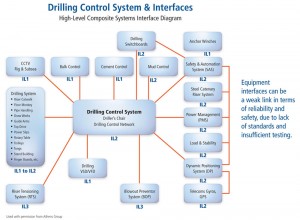ABS issues guidance to minimize software-related errors on rigs
 On today’s highly complex and computerized offshore drilling vessels, one critical component ensures that the multiple control systems are properly working in a smooth and integrated manner: software. Software powers everything from the mud and cement systems to the blowout preventer to the power management system, all of which lead to the heart of the operation – the drilling control system.
On today’s highly complex and computerized offshore drilling vessels, one critical component ensures that the multiple control systems are properly working in a smooth and integrated manner: software. Software powers everything from the mud and cement systems to the blowout preventer to the power management system, all of which lead to the heart of the operation – the drilling control system.
With the increasing reliance on computer-controlled systems, the offshore industry has recognized the need for software validation to ensure systems operate efficiently and in concert with each other. To that end, classification society American Bureau of Shipping (ABS) has developed the Integrated Software Quality Management (ISQM) guide, a risk-based software development and maintenance process built on industry-recognized standards.
The process is designed to mitigate software errors and ensure the software functions the way it was intended. The goal is to reduce nonproductive time (NPT) and save time during rig commissioning. To improve the overall function of the drilling control system, the ISQM program also has the potential to enhance safety on the vessel and to reduce environmental impact. The process manages software over the life of the vessel.
“ISQM is an important piece of the overall asset integrity management on offshore rigs,” said Bret Montaruli, ABS vice president, offshore technology. Founded in 1862, ABS is an international classification society committed to promote the security of life, property and the marine environment through the development and verification of standards for the design, construction and operational maintenance of marine-related facilities.
A key element of the ISQM process is system integration, as many rig functions rely on various software programs developed by multiple vendors. Each software system controls individual components, but they all must communicate to a central location – the drilling control system. If one software manufacturer is not using the same communication protocol as another vendor, that can lead to problems.
“That is essentially what this system is addressing,” Mr Montaruli explained. “Making sure the systems talk to each other when they’re supposed to talk to each other and do what they are intended to do.”
The protocol has been in development for a year and was introduced in August. It also offers an optional notation that vessels receive when they meet all the ISQM requirements. It addresses the implementation, testing and maintenance of the software through five stages:
- Concept: The people who use the system identify the functions and determine how the system is supposed to operate;
- Requirements: Provides specifications to the engineers who develop the software;
- Development and code-writing;
- Validation: An ongoing process to ensure the software was developed according to the specifications, meets the operator’s needs and performs properly;
- Operation: A continuing maintenance process monitoring the system for consistency when there are software upgrades and new releases or changes in hardware. Routine software upgrades can introduce errors into the system that result in operational problems.
The development of the ISQM process is indicative of the challenges the industry is facing with increasingly complex computerized systems on offshore rigs, Mr Montaruli noted. “The offshore industry has traditionally focused on structures and equipment. However, software has become such an important component in the operational phase; it also must be given special consideration,” he said. “The benefit to owners is an increased level of confidence in software reliability, with the goal of decreasing downtime and reducing the risk of software-related incidents.”




